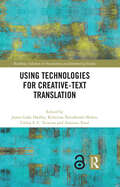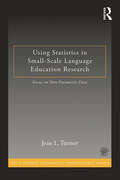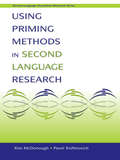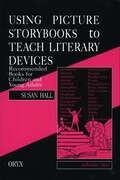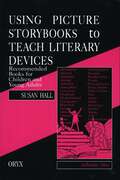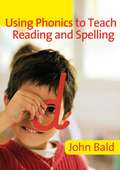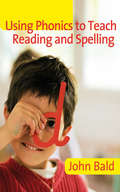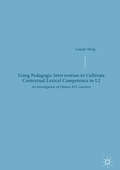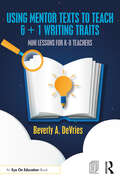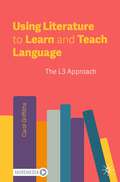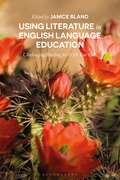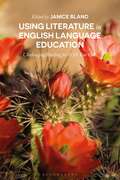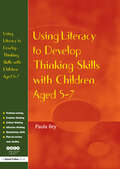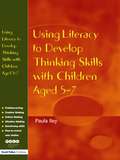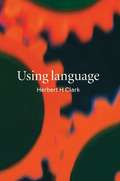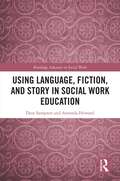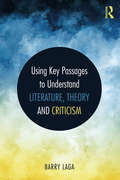- Table View
- List View
Using Technologies for Creative-Text Translation (Routledge Advances in Translation and Interpreting Studies)
by James Luke Hadley Kristiina Taivalkoski-Shilov Antonio Toral Teixeira, Carlos S. C.This collection reflects on the state of the art of research into the use of translation technologies in the translation of creative texts, encompassing literary texts but also extending beyond to cultural texts, and charts their development and paths for further research. Bringing together perspectives from scholars across the discipline, the book considers recent trends and developments in technology that have spurred growing interest in the use of computer-aided translation (CAT) and machine translation (MT) tools in literary translation. Chapters examine the relationships between translators and these tools–the extent to which they already use such technologies, the challenges they face, and prevailing attitudes towards these tools–as well as the ethical implications of such technologies in translation practice. The volume gives special focus to drawing on examples with and beyond traditional literary genres to look to these technologies’ use in working with the larger group of creative texts, setting the stage for many future research opportunities. The book will be of particular interest to students and scholars in translation studies, especially those with an interest in literary translation, translation technology, translation practice, and translation ethics.
Using Statistics In Small-scale Language Education Research: Focus On Non-parametric Data (Esl And Applied Linguistics Professional Ser.)
by Jean TurnerAssuming no familiarity with statistical methods, this text for language education research methods and statistics courses provides detailed guidance and instruction on principles of designing, conducting, interpreting, reading, and evaluating statistical research done in classroom settings or with a small number of participants. While three different types of statistics are addressed (descriptive, parametric, non-parametric) the emphasis is on non-parametric statistics because they are appropriate when the number of participants is small and the conditions for use of parametric statistics are not satisfied. The emphasis on non-parametric statistics is unique and complements the growing interest among second and foreign language educators in doing statistical research in classrooms. Designed to help students and other language education researchers to identify and use analyses that are appropriate for their studies, taking into account the number of participants and the shape of the data distribution, the text includes sample studies to illustrate the important points in each chapter and exercises to promote understanding of the concepts and the development of practical research skills. Mathematical operations are explained in detail, and step-by-step illustrations in the use of R (a very powerful, online, freeware program) to perform all calculations are provided. A Companion Website extends and enhances the text with PowerPoint presentations illustrating how to carry out calculations and use R; practice exercises with answer keys; data sets in Excel MS-DOS format; and quiz, midterm, and final problems with answer keys.
Using Statistics in Small-Scale Language Education Research: Focus On Non-parametric Data (Esl And Applied Linguistics Professional Ser.)
by Jean TurnerAssuming no familiarity with statistical methods, this text for language education research methods and statistics courses provides detailed guidance and instruction on principles of designing, conducting, interpreting, reading, and evaluating statistical research done in classroom settings or with a small number of participants. While three different types of statistics are addressed (descriptive, parametric, non-parametric) the emphasis is on non-parametric statistics because they are appropriate when the number of participants is small and the conditions for use of parametric statistics are not satisfied. The emphasis on non-parametric statistics is unique and complements the growing interest among second and foreign language educators in doing statistical research in classrooms. Designed to help students and other language education researchers to identify and use analyses that are appropriate for their studies, taking into account the number of participants and the shape of the data distribution, the text includes sample studies to illustrate the important points in each chapter and exercises to promote understanding of the concepts and the development of practical research skills. Mathematical operations are explained in detail, and step-by-step illustrations in the use of R (a very powerful, online, freeware program) to perform all calculations are provided. A Companion Website extends and enhances the text with PowerPoint presentations illustrating how to carry out calculations and use R; practice exercises with answer keys; data sets in Excel MS-DOS format; and quiz, midterm, and final problems with answer keys.
Using The River (Rigby Star Guided #Lime Level)
by Claire LlewellynRigby Star is a guided reading programme developed specifically to meet the requirements of the NLS. It offers stories and teaching support to help plan and manage guided reading lessons - all within a structured reading programme. Teaching versions offer support for every title, with prompts for discussing the story summary; preparing pupils for the walkthrough, in which the pupils think about such clues to the book as the blurb, the cover image and title. The readers are part of a carefully levelled structure to help ensure that every child has the right book, at the right time. Every book has links to independent/group reading and writing activities. The scheme also offers support for follow-up and assessment, such as suggestions for further activities and assessment. There is a writing activity linked to every book.
Using The River (Rigby Star Guided #Lime Level)
by Claire LlewellynRigby Star is a guided reading programme developed specifically to meet the requirements of the NLS. It offers stories and teaching support to help plan and manage guided reading lessons - all within a structured reading programme. Teaching versions offer support for every title, with prompts for discussing the story summary; preparing pupils for the walkthrough, in which the pupils think about such clues to the book as the blurb, the cover image and title. The readers are part of a carefully levelled structure to help ensure that every child has the right book, at the right time. Every book has links to independent/group reading and writing activities. The scheme also offers support for follow-up and assessment, such as suggestions for further activities and assessment. There is a writing activity linked to every book.
Using Priming Methods in Second Language Research (Second Language Acquisition Research Series)
by Kim McDonough Pavel TrofimovichUsing Priming Methods in Second Language Research is an accessible introduction to the use of auditory, semantic, and syntactic priming methods for second language (L2) processing and acquisition research. It provides a guide for the use, design, and implementation of priming tasks and an overview of how to analyze and report priming research. Key principles about auditory, semantic, and syntactic priming are introduced, and issues for L2 researchers to consider when designing priming studies are pointed out. Empirical studies that have adopted priming methods are highlighted to illustrate the application of experimental techniques from psychology to L2 processing and acquisition research. Each chapter concludes with follow-up questions and activities that provide additional reinforcement of the chapter content, while the final chapter includes data sets that can be used to practice the statistical tests commonly used with priming data.
Using Priming Methods in Second Language Research (Second Language Acquisition Research Series)
by Kim McDonough Pavel TrofimovichUsing Priming Methods in Second Language Research is an accessible introduction to the use of auditory, semantic, and syntactic priming methods for second language (L2) processing and acquisition research. It provides a guide for the use, design, and implementation of priming tasks and an overview of how to analyze and report priming research. Key principles about auditory, semantic, and syntactic priming are introduced, and issues for L2 researchers to consider when designing priming studies are pointed out. Empirical studies that have adopted priming methods are highlighted to illustrate the application of experimental techniques from psychology to L2 processing and acquisition research. Each chapter concludes with follow-up questions and activities that provide additional reinforcement of the chapter content, while the final chapter includes data sets that can be used to practice the statistical tests commonly used with priming data.
Using Picture Storybooks to Teach Literary Devices: Recommended Books for Children and Young Adults (Using Picture Books to Teach)
by Susan HallThe third volume of Using Picture Storybooks to Teach Literary Devices joins volumes 1 and 2 of this best-selling series to give teachers and librarians the perfect tool to teach literary devices to students in grades K-12. In this volume, 120 well-reviewed picture storybooks, published mainly in the last few years, are listed (sometimes more than once) under 41 literary devices. All-ages picture storybooks, which can be enjoyed by adults, as well as children, are included. For each device, a definition is given, and descriptions of appropriate storybooks, with information on how to use them, the art style used in the book, and a curriculum tie-in, are provided. Among the literary devices included are alliteration, analogy, flashback, irony, metaphor, paradox, tone, and 34 more. Indexes by author, title, art style, and curriculum tie-in add to this outstanding book's great value. Grades 4-12.
Using Picture Storybooks to Teach Literary Devices: Recommended Books for Children and Young Adults (Using Picture Books to Teach)
by Susan HallThe third volume of Using Picture Storybooks to Teach Literary Devices joins volumes 1 and 2 of this best-selling series to give teachers and librarians the perfect tool to teach literary devices to students in grades K-12. In this volume, 120 well-reviewed picture storybooks, published mainly in the last few years, are listed (sometimes more than once) under 41 literary devices. All-ages picture storybooks, which can be enjoyed by adults, as well as children, are included. For each device, a definition is given, and descriptions of appropriate storybooks, with information on how to use them, the art style used in the book, and a curriculum tie-in, are provided. Among the literary devices included are alliteration, analogy, flashback, irony, metaphor, paradox, tone, and 34 more. Indexes by author, title, art style, and curriculum tie-in add to this outstanding book's great value. Grades 4-12.
Using Phonics to Teach Reading & Spelling (PDF)
by John BaldIncludes CD-Rom Times Educational Supplement Star Read! 'This is an authoritative yet lively and eminently readable book. It is well grounded in both the latest academic theory and experienced hands-on pedagogic practice, and it summarises succinctly the implications of the recent Rose Report, giving a masterly exposition of both synthetic and analytic phonics and their places in the processes of learning to read and spell. Practical and organisational issues are tackled in a most supportive way, with very useful checklists and photocopiable proformas on an accompanying CD. The book also provides and excellent guide to provision for professional development, involving the use of lesson observation and part of the evaluation and planning cycle for CPD. Its style is clear and well signposted with subheadings, case-study boxes to illuminate points, and with aims given at the start of each chapter as well as challenging points for reflection and guides to further reading at the ends. Every staff room should have one!' - Dorothy Latham, Primary Education Consultant, English specialist and author of How Children Learn to Write 'Synthetic phonics may well be only one tool for teaching reading and spelling, but it is the single most important one' - Ruth Kelly, Education Secretary, March 2006 'Teachers - and particularly Literacy Co-ordinators or SENCOs - who are enthusiastic about children's learning and about their own professional development will undoubtedly benefit from using this book and CD, with its combination of useful explanation and practical resources to support the implementation of the ideas' - Lorna Gardiner, General Adviser, Foundation Stage, North Eastern Education and Library Board, Northern Ireland Are you looking for practical advice on how to teach phonics? By giving the reader a basic introduction to teaching reading and spelling using phonics, this book will provide you with easy-to-use ideas for your classrooms. Following on from the recommendations of the Rose Report, the author explains why teaching phonics works, and how to present irregular as well as straightforward features of English. The book: o contains practical examples and activities for teachers o explains the basis of synthetic and analytic phonics o gives advice on choosing the best resources o looks at how to help the weakest readers o includes a CD Rom with photocopiable resources and INSET materials o contains a glossary of key terms Literacy Co-ordinators, teachers and teaching assistants will find this an invaluable resource.
Using Phonics to Teach Reading & Spelling
by John BaldIncludes CD-Rom Times Educational Supplement Star Read! 'This is an authoritative yet lively and eminently readable book. It is well grounded in both the latest academic theory and experienced hands-on pedagogic practice, and it summarises succinctly the implications of the recent Rose Report, giving a masterly exposition of both synthetic and analytic phonics and their places in the processes of learning to read and spell. Practical and organisational issues are tackled in a most supportive way, with very useful checklists and photocopiable proformas on an accompanying CD. The book also provides and excellent guide to provision for professional development, involving the use of lesson observation and part of the evaluation and planning cycle for CPD. Its style is clear and well signposted with subheadings, case-study boxes to illuminate points, and with aims given at the start of each chapter as well as challenging points for reflection and guides to further reading at the ends. Every staff room should have one!' - Dorothy Latham, Primary Education Consultant, English specialist and author of How Children Learn to Write 'Synthetic phonics may well be only one tool for teaching reading and spelling, but it is the single most important one' - Ruth Kelly, Education Secretary, March 2006 'Teachers - and particularly Literacy Co-ordinators or SENCOs - who are enthusiastic about children's learning and about their own professional development will undoubtedly benefit from using this book and CD, with its combination of useful explanation and practical resources to support the implementation of the ideas' - Lorna Gardiner, General Adviser, Foundation Stage, North Eastern Education and Library Board, Northern Ireland Are you looking for practical advice on how to teach phonics? By giving the reader a basic introduction to teaching reading and spelling using phonics, this book will provide you with easy-to-use ideas for your classrooms. Following on from the recommendations of the Rose Report, the author explains why teaching phonics works, and how to present irregular as well as straightforward features of English. The book: o contains practical examples and activities for teachers o explains the basis of synthetic and analytic phonics o gives advice on choosing the best resources o looks at how to help the weakest readers o includes a CD Rom with photocopiable resources and INSET materials o contains a glossary of key terms Literacy Co-ordinators, teachers and teaching assistants will find this an invaluable resource.
Using Phonics to Teach Reading and Spelling (PDF)
by John BaldIncludes CD-Rom. Times Educational Supplement Star Read!. 'This is an authoritative yet lively and eminently readable book. It is well grounded in both the latest academic theory and experienced hands-on pedagogic practice, and it summarises succinctly the implications of the recent Rose Report, giving a masterly exposition of both synthetic and analytic phonics and their places in the processes of learning to read and spell. Practical and organisational issues are tackled in a most supportive way, with very useful checklists and photocopiable proformas on an accompanying CD. The book also provides an excellent guide to provision for professional development, involving the use of lesson observation and part of the evaluation and planning cycle for CPD. Its style is clear and well signposted with subheadings, case-study boxes to illuminate points, and with aims given at the start of each chapter as well as challenging points for reflection and guides to further reading at the ends. Every staff room should have one!' - Dorothy Latham, Primary Education Consultant, English specialist and author of How Children Learn to Write. 'Synthetic phonics may well be only one tool for teaching reading and spelling, but it is the single most important one' - Ruth Kelly, Education Secretary, March 2006. 'Teachers - and particularly Literacy Co-ordinators or SENCOs - who are enthusiastic about children's learning and about their own professional development will undoubtedly benefit from using this book and CD, with its combination of useful explanation and practical resources to support the implementation of the ideas' - Lorna Gardiner, General Adviser, Foundation Stage, North Eastern Education and Library Board, Northern Ireland. Are you looking for practical advice on how to teach phonics? By giving the reader a basic introduction to teaching reading and spelling using phonics, this book will provide you with easy-to-use ideas for your classrooms. Following on from the recommendations of the Rose Report, the author explains why teaching phonics works, and how to present irregular as well as straightforward features of English. The book: contains practical examples and activities for teachers explains the basis of synthetic and analytic phonics gives advice on choosing the best resources looks at how to help the weakest readers includes a CD Rom with photocopiable resources and INSET materials contains a glossary of key terms. Literacy Co-ordinators, teachers and teaching assistants will find this an invaluable resource.
Using Pedagogic Intervention to Cultivate Contextual Lexical Competence in L2: An Investigation of Chinese EFL Learners
by Gaiyan WangThis book challenges prevailing linguistic presumptions concerning contextual lexical meaning by examining whether pedagogic intervention targeted at raising Chinese EFL learners’ awareness of the pragmatic nature of contextual lexical meaning can enhance the learners’ contextual lexical inferencing competence (CLIC). CLIC is crucial to the development of a learners’ vocabulary, reading ability and autonomy in reading. Through an empirical study conducted among a group of adult Chinese students of English, the author shows that the power of CLIC instruction lies mainly in its effectiveness in enhancing learners’ self-confidence in making lexical inferences. This book will be of interest to researchers and students of applied linguistics, TESOL, language education, and for language professionals keen to extend their research experience.
Using Pedagogic Intervention to Cultivate Contextual Lexical Competence in L2: An Investigation of Chinese EFL Learners
by Gaiyan WangThis book challenges prevailing linguistic presumptions concerning contextual lexical meaning by examining whether pedagogic intervention targeted at raising Chinese EFL learners’ awareness of the pragmatic nature of contextual lexical meaning can enhance the learners’ contextual lexical inferencing competence (CLIC). CLIC is crucial to the development of a learners’ vocabulary, reading ability and autonomy in reading. Through an empirical study conducted among a group of adult Chinese students of English, the author shows that the power of CLIC instruction lies mainly in its effectiveness in enhancing learners’ self-confidence in making lexical inferences. This book will be of interest to researchers and students of applied linguistics, TESOL, language education, and for language professionals keen to extend their research experience.
Using Mentor Texts to Teach 6 + 1 Writing Traits: Mini Lessons for K-8 Teachers
by Beverly A. DeVriesIn this book, you’ll find a wealth of mini lessons designed to improve the quality of students’ writing. Each lesson uses a key mentor text and spotlights one of the 6 + 1 Writing Traits to allow students to focus on the essential aspects of good writing – content, organization, word choice, voice, sentence fluency, conventions, and presentation. Inviting and practical, the lessons are concise and follow a consistent model for easy implementation. With seven lessons per chapter, each includes step-by-step guidance, open-ended prompts, and suggestions for additional suitable mentor texts. The chapters are organized by genre – including fiction, informational texts, and poetry – and feature graphic novels and graphic informational mentor texts to inspire and engage students. Aligned with the Common Core State Standards, this resource is essential for any K-8 or pre-service teacher who wants to instill in their students the skills to become independent, confident writers.
Using Mentor Texts to Teach 6 + 1 Writing Traits: Mini Lessons for K-8 Teachers
by Beverly A. DeVriesIn this book, you’ll find a wealth of mini lessons designed to improve the quality of students’ writing. Each lesson uses a key mentor text and spotlights one of the 6 + 1 Writing Traits to allow students to focus on the essential aspects of good writing – content, organization, word choice, voice, sentence fluency, conventions, and presentation. Inviting and practical, the lessons are concise and follow a consistent model for easy implementation. With seven lessons per chapter, each includes step-by-step guidance, open-ended prompts, and suggestions for additional suitable mentor texts. The chapters are organized by genre – including fiction, informational texts, and poetry – and feature graphic novels and graphic informational mentor texts to inspire and engage students. Aligned with the Common Core State Standards, this resource is essential for any K-8 or pre-service teacher who wants to instill in their students the skills to become independent, confident writers.
Using Literature to Learn and Teach Language: The L3 Approach
by Carol GriffithsThis accessibly-written textbook uses the intrinsic appeal of a story to engage students with language, and provides teachers with the background knowledge and the skills to use literature to construct lessons for their classes which integrate all four skills plus language awareness in an enjoyable way. Although a number of books and studies have examined the value of using literature to learn language, literature remains under-represented as a language learning resource. The author argues that the accumulated body of literature represents a bottomless pit of potential material, just waiting to be recognised and enjoyed. From a teacher’s point of view, a lesson based on a literary work can provide an integrated approach to language development which few other approaches can match. A piece of literature can be used to develop all four skills, both receptive and productive (reading, writing, listening speaking) as well as production skills and language awareness. This book willbe an essential resource for pre-service and in-service teachers, teacher trainers, students and scholars of Applied Linguistics, Language Education, TESOL and related subjects.
Using Literature in English Language Education: Challenging Reading for 8–18 Year Olds
by Janice BlandCovering Green's The Fault in Our Stars, Collins' The Hunger Games, Selznick's The Invention of Hugo Cabret, Rowling's Wizarding World, Staake's Bluebird and Winton's Lockie Leonard, contributors consider how literature can be used for teaching literary literacy, creative writing, intercultural learning, critical pedagogy and deep reading in school settings where English is the teaching medium. Leading scholars from around the world explore pedagogical principles for English Language Teaching (ELT) widening children's and teenagers' literacy competences as well as their horizons through insightful engagement with texts. From challenging picturebooks for primary and secondary students, to graphic novels, to story apps, film and drama, as well as speculative fiction on provocative topics, recent research on literature education in ELT settings combines with cognitive criticism in the field of children's, young adult and adult literature.
Using Literature in English Language Education: Challenging Reading for 8–18 Year Olds
by Janice BlandCovering Green's The Fault in Our Stars, Collins' The Hunger Games, Selznick's The Invention of Hugo Cabret, Rowling's Wizarding World, Staake's Bluebird and Winton's Lockie Leonard, contributors consider how literature can be used for teaching literary literacy, creative writing, intercultural learning, critical pedagogy and deep reading in school settings where English is the teaching medium. Leading scholars from around the world explore pedagogical principles for English Language Teaching (ELT) widening children's and teenagers' literacy competences as well as their horizons through insightful engagement with texts. From challenging picturebooks for primary and secondary students, to graphic novels, to story apps, film and drama, as well as speculative fiction on provocative topics, recent research on literature education in ELT settings combines with cognitive criticism in the field of children's, young adult and adult literature.
Using Literacy to Develop Thinking Skills with Children Aged 5 -7
by Paula IleyThese creative off-the-shelf activities will spark children's thinking skills through speaking, listening, reading and writing. Busy teachers wanting to shake up their lessons will find them indispensable. Includes: problem-solving; creative and critical thinking; emotional thinking; questioning skills and plan-do-review formats clear explanation of underpinning theory advice on differentiating activities links to the National Literacy Strategy Framework.
Using Literacy to Develop Thinking Skills with Children Aged 5 -7
by Paula IleyThese creative off-the-shelf activities will spark children's thinking skills through speaking, listening, reading and writing. Busy teachers wanting to shake up their lessons will find them indispensable. Includes: problem-solving; creative and critical thinking; emotional thinking; questioning skills and plan-do-review formats clear explanation of underpinning theory advice on differentiating activities links to the National Literacy Strategy Framework.
Using Language (PDF)
by Herbert ClarkThis book, first published in 1996, argues that language use is more than the sum of a speaker speaking and a listener listening. It is the joint action that emerges when speakers and listeners - writers and readers - perform their individual actions in coordination, as ensembles. The author argues strongly that language use embodies both individual and social processes. This book, first published in 1996, argues that language use is more than the sum of a speaker speaking and a listener listening. It is the joint action that emerges when speakers and listeners - writers and readers - perform their individual actions in coordination, as ensembles. The author argues strongly that language use embodies both individual and social processes.
Using Language, Fiction, and Story in Social Work Education (Routledge Advances in Social Work)
by Dara Sampson Amanda HowardThis book provides an accessible, research-informed text for social work educators, students, and practitioners interested in the use of story to engender the connection of human experiences with ideas, theories, and skills. A broad lens is also taken to the ways in which fiction has been used as a teaching tool in other degrees, ranging from medicine to engineering to philosophy and economics. Although the research explored is social work specific, this text has applicability for any educator looking for creative methods to teach complex theories, skills, and concepts. Showing how fiction can be used in social work education, it explains why story matters to social work and how fiction can emulate these stories, as well as the capacity of fiction to evoke empathy. Ways in which educators can enlist fiction to create a ‘safe space’ for the exploration of complex emotional terrain are explored, as are the ways in which a community of practice can be created through fiction. Woven within the end of every chapter are some practice examples and author conversations which work to locate the research into a practice context. The text concludes with examples of how fiction has been effectively utilised by the authors, in order to provide a starting point for those interested in exploring this pedagogical approach further.
Using Language, Fiction, and Story in Social Work Education (Routledge Advances in Social Work)
by Dara Sampson Amanda HowardThis book provides an accessible, research-informed text for social work educators, students, and practitioners interested in the use of story to engender the connection of human experiences with ideas, theories, and skills. A broad lens is also taken to the ways in which fiction has been used as a teaching tool in other degrees, ranging from medicine to engineering to philosophy and economics. Although the research explored is social work specific, this text has applicability for any educator looking for creative methods to teach complex theories, skills, and concepts. Showing how fiction can be used in social work education, it explains why story matters to social work and how fiction can emulate these stories, as well as the capacity of fiction to evoke empathy. Ways in which educators can enlist fiction to create a ‘safe space’ for the exploration of complex emotional terrain are explored, as are the ways in which a community of practice can be created through fiction. Woven within the end of every chapter are some practice examples and author conversations which work to locate the research into a practice context. The text concludes with examples of how fiction has been effectively utilised by the authors, in order to provide a starting point for those interested in exploring this pedagogical approach further.
Using Key Passages to Understand Literature, Theory and Criticism
by Barry LagaUsing Key Passages to Understand Literature, Theory and Criticism is a completely fresh and innovative approach to teaching and learning literary theory: using short passages of theory to make sense of literary and cultural texts. It focuses on the key concepts that help readers understand literature and cultural events in new and provocative ways. Covering a wide variety of iconic and contemporary theorists, the book offers a broad chronological and global overview, including thirty passages from theorists such as Viktor Shklovsky, Roland Barthes, Judith Butler, Diana Fuss, Jean Baudrillard, Kwame Anthony Appiah, Michel Foucault, Monique Wittig, and Eve Sedgwick. Built on the premise that scholars use theory pragmatically, Using Key Passages to Understand Literature, Theory and Criticism identifies problems, puzzles, and questions readers may encounter when they read a story, watch a film, or look at artwork. It explains, in detail, thirty concepts that help readers make sense of these works and invites students to apply the concepts to a range of writing and research projects. The textbook concludes by helping students read theory with an eye on finding productive passages and writing their own “theory chapter,” signaling a shift from student as critic to student as theorist. Used as a main text in introductory theory courses or as a supplement to any literature, film, theater, or art course, this book helps students read closely and think critically.
